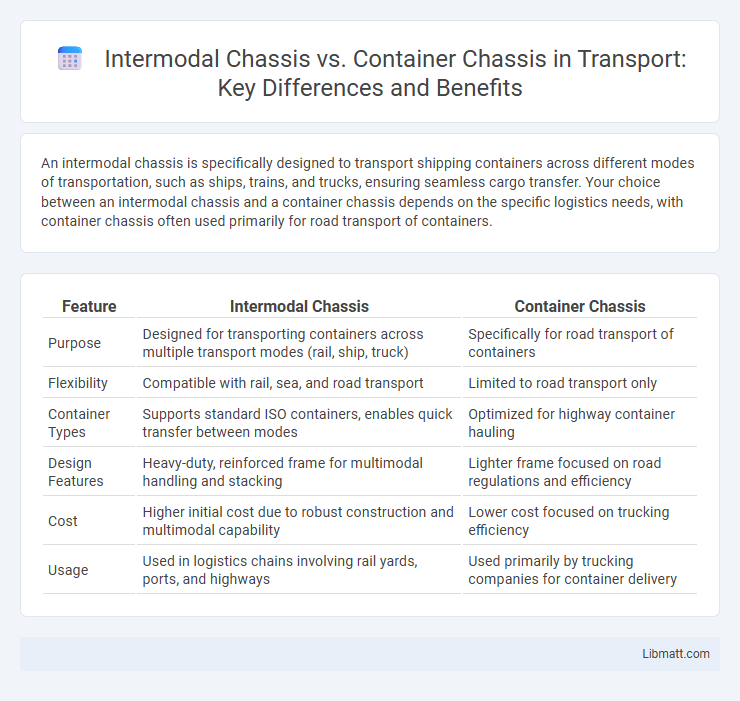An intermodal chassis is specifically designed to transport shipping containers across different modes of transportation, such as ships, trains, and trucks, ensuring seamless cargo transfer. Your choice between an intermodal chassis and a container chassis depends on the specific logistics needs, with container chassis often used primarily for road transport of containers.
Table of Comparison
| Feature | Intermodal Chassis | Container Chassis |
|---|---|---|
| Purpose | Designed for transporting containers across multiple transport modes (rail, ship, truck) | Specifically for road transport of containers |
| Flexibility | Compatible with rail, sea, and road transport | Limited to road transport only |
| Container Types | Supports standard ISO containers, enables quick transfer between modes | Optimized for highway container hauling |
| Design Features | Heavy-duty, reinforced frame for multimodal handling and stacking | Lighter frame focused on road regulations and efficiency |
| Cost | Higher initial cost due to robust construction and multimodal capability | Lower cost focused on trucking efficiency |
| Usage | Used in logistics chains involving rail yards, ports, and highways | Used primarily by trucking companies for container delivery |
Introduction to Intermodal Chassis and Container Chassis
Intermodal chassis and container chassis are essential components in freight transportation, designed to securely carry shipping containers over different transport modes. Intermodal chassis specifically support the transfer of containers between ships, trains, and trucks, optimizing the efficiency of global supply chains. Your choice between these chassis types impacts cargo handling flexibility, operational costs, and overall logistics performance.
Definition: What Is an Intermodal Chassis?
An intermodal chassis is a specialized trailer frame designed to carry shipping containers in intermodal transportation, enabling seamless transfer between ships, trains, and trucks. Unlike standard container chassis, intermodal chassis are engineered to meet specific standards for secure container locking and efficient handling in multiple transport modes. These chassis enhance logistics efficiency by supporting the rapid movement of containers across diverse transportation networks.
Definition: What Is a Container Chassis?
A container chassis is a specialized trailer designed specifically to transport intermodal containers, providing a secure frame that supports the container's standardized locking points. Unlike an intermodal chassis, which may accommodate different cargo types and trailer configurations, the container chassis is purpose-built for efficient container handling and transfer between ships, trucks, and trains. Choosing the right container chassis ensures your freight remains stable and compliant throughout its intermodal journey.
Key Differences Between Intermodal and Container Chassis
Intermodal chassis are designed specifically for transporting containers across multiple transportation modes, such as ships, trucks, and trains, with standardized fittings to secure containers of various sizes. Container chassis, on the other hand, are primarily built for truck use, optimized for road hauling and may not always be compatible with intermodal transfer equipment. Understanding these key differences ensures your cargo is matched with the appropriate chassis, enhancing efficiency and safety throughout the supply chain.
Design and Structural Comparison
Intermodal chassis are specifically engineered for seamless transfer between multiple transportation modes, featuring reinforced frames and adjustable configurations to accommodate various container sizes and weights. Container chassis typically have a simpler, standardized design optimized for road transport, with fixed dimensions tailored to securely hold standard containers. The intermodal chassis emphasizes durability and flexibility in structural components to withstand frequent handling and mode transitions, while container chassis prioritize stability and compatibility with trucking operations.
Usage Scenarios: Intermodal vs. Container Chassis
Intermodal chassis are designed for seamless transfer between different transportation modes, such as ships, trains, and trucks, making them ideal for long-haul logistics and efficient supply chain operations. Container chassis, on the other hand, are primarily used for drayage, transporting containers short distances between ports, warehouses, and distribution centers. Your choice depends on whether you need versatile equipment for intermodal freight movement or specialized chassis optimized for terminal and local container handling.
Compatibility With Shipping Modes and Containers
Intermodal chassis are designed to be compatible with multiple shipping modes, including rail, truck, and ship, allowing seamless transfer of containers across transportation methods. Container chassis are specifically built to support standard ISO containers, ensuring secure handling and stability during road transport. Your choice between these chassis should consider the need for flexibility across diverse shipping routes and container types to optimize logistics efficiency.
Cost and Maintenance Considerations
Intermodal chassis typically involve higher initial costs due to specialized configurations designed for seamless integration with multiple transport modes, but they benefit from reduced long-term maintenance expenses because of durable, modular components. Container chassis generally have lower upfront costs, yet maintenance can be more frequent and costly because of varying load conditions and wear from different container sizes. Choosing between intermodal and container chassis depends on balancing upfront investment against ongoing service and repair costs aligned with specific transportation needs.
Advantages and Disadvantages of Each Chassis Type
Intermodal chassis offer versatility by supporting multiple cargo types and enabling seamless transfer between transportation modes, reducing handling costs, but they tend to be heavier and may have limited availability. Container chassis are specifically designed for container transport, providing better weight distribution and fuel efficiency, yet they lack the flexibility to carry other freight types and can incur higher rental fees. Your choice depends on operational needs, balancing the intermodal chassis's adaptability against the container chassis's specialized performance.
Choosing the Right Chassis for Your Logistics Needs
Choosing the right chassis for your logistics needs depends on the type of cargo and transportation methods you prioritize. Intermodal chassis are designed for seamless transfer between rail, road, and sea, facilitating efficient container movement across multiple modes, while container chassis are typically optimized for highway transport of containers directly from ports to warehouses. Evaluating your shipping routes, cargo size, and handling requirements ensures you select a chassis that maximizes operational efficiency and reduces transit costs.
intermodal chassis vs container chassis Infographic

 libmatt.com
libmatt.com